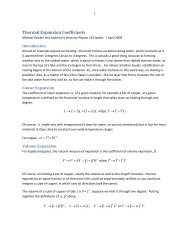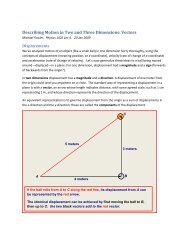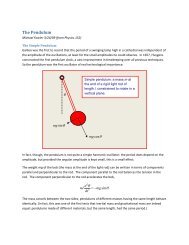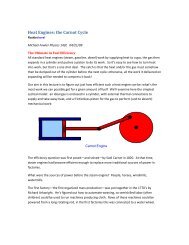Class Notes on Rotational Motion - Galileo and Einstein
Class Notes on Rotational Motion - Galileo and Einstein
Class Notes on Rotational Motion - Galileo and Einstein
Create successful ePaper yourself
Turn your PDF publications into a flip-book with our unique Google optimized e-Paper software.
14Therefore, the total energy is just the sum of the translati<strong>on</strong>al kinetic energy <strong>and</strong> the rotati<strong>on</strong>al kineticenergy:E Mv I1 2 1 22 CM 2where I is the moment of inertia about the center of mass.So what does this mean for the hoop? If it’s rolling at speed v, it’s rotating at angular speed v/R ,<strong>and</strong> since its moment of inertia is MR 2 , its total energy is1 2 1 2 1 2 1 2 2 2E 2Mv 2I2Mv 2MR ( v / R) Mv .So it has twice the kinetic energy of a block of the same mass sliding down at the same speed. Putanother way, a block sliding down through a height h will have speed given by v 2 = 2gh, the hoop will<strong>on</strong>ly reach speed v 2 = gh, because it will have lost the same amount of potential energy, so must havethe same total kinetic energy—including the rotati<strong>on</strong>al kinetic energy, which the block didn’t have.The equati<strong>on</strong> F = ma still describes its linear moti<strong>on</strong> down the ramp, <strong>and</strong> after descending a distance xits velocity is given by v 2 = 2ax. Evidently, the rolling hoop has <strong>on</strong>ly half the accelerati<strong>on</strong> of the slidingblock, so must <strong>on</strong>ly be subject to half the force pulling it downhill. The difference is the retarding staticfricti<strong>on</strong>al force at the point of c<strong>on</strong>tact: that must be just half of the gravitati<strong>on</strong>al force comp<strong>on</strong>entpointing down the hill. If there isn’t enough fricti<strong>on</strong>, the hoop will slide without increasing its angularvelocity. (Note: the hoop has <strong>on</strong>ly half the accelerati<strong>on</strong> of the block, but reaches a final velocity greaterthan half that of the block, because it accelerates for a l<strong>on</strong>ger time.)














